Emma
Addicted Member
  My baby Jingo
My baby Jingo
Posts: 111
|
Post by Emma on Apr 26, 2011 20:34:09 GMT 10
From what I have been reading about green cheek conure genetics it explains that cinnamon is a sex-linked mutation. But I don't quite understand, here is a section from what I've been reading: "Cinnamon Green-Cheeks are a Sex-Linked Mutation this means ONLY a cock can be split for the color and all hens are either Cinnamon or not
Cinnamon Cock x Normal Hen = Normal split Cinnamon Cocks & Cinnamon Hens
Normal Cock x Cinnamon Hen = Normal split Cinnamon Cocks & Normal Hens
Normal split Cinnamon Cock x Cinnamon Hen =
Normal split Cinnamon & Cinnamon Cocks & Normal & Cinnamon Hens "" this means ONLY a cock can be split for the color and all hens are either Cinnamon or not " What does it mean by 'split for the colour' and 'normal split cinnamon'? (Sorry if that ones a stupid question) If someone could just explain this sex linked mutation in different words maybe?  I find gentics really interesting but I just don't understand this, does it just mean the gene is carried by one sex so a cin male with a normal female only male babies will be cinn? I'm quite confused haha  If anyone could help it would be lovely thanks.  Eb |
|
Emma
Addicted Member
  My baby Jingo
My baby Jingo
Posts: 111
|
Post by Emma on Apr 26, 2011 21:44:55 GMT 10
Does normal split cinnamon cocks just mean a normal cock carrying cinnamon gene? And does that work the other way around, like cinnamon cock carrying normal gene?
|
|
|
|
Post by avinet on Apr 26, 2011 22:41:02 GMT 10
There is nothing like genetics to get the mind all twisted up! This will be by necessitiy a bit long but bear with me  Basically all colour mutations are a result of variations in the genes for colour that the bird carries - the genes that define the basic normal (which means the wild) appearance of the bird. Variations to these genes can result in colours that are different to the wild bird's colours. Firstly the term "split" means that the bird is carrying a gene for a colour mutation but that colour is not visible; for one reason or another it is masked by another colour gene - usually the normal gene. Thus a normal split cinnamon male has the normal colour of a Green-cheek but is carrying the cinnamon gene and that gene is stopped from appearing by the normal colour gene the bird also is carrying. Like us, birds have a set of chromosomes, that occur in pairs, and in birds the X and Y chromosomes are the ones that concern the gender of the bird. Males have two X chromosomes while females have one X and one Y chromosome. Each male passes on one X and each female either her X or her Y to the baby. If the baby ends up with two X's then it will be a male, if it ends up with a Y it will be a female. In birds the female decides the sex of the baby, the opposite to humans, where males are XY and females YY. This is important because in birds the Y does not carry any colour genes at all. In the case of a sex linked mutation the gene for the colour is carried on the X chromosome - hence the term sex-linked mutation. However the possession of a sex-linked gene does not automatically result in the bird being that colour since if it is a male, and one X has the sex-linked gene and the other X does not, then the male will be a normal colour since normal is a dominant colour over a sex-linked mutation. The male will however be split to the sex-linked mutation. However with the female, if it inherits an X carrying the gene it will have that colour, since it's Y chromosome does not carry any colour information to mask the mutation colour. That is why the female cannot be split to a sex-linked colour - her second sex chromosome, the Y, cannot carry any colour mutation genes, and if she has it on her X then she will show the colour. The end result is that if a male passes on a sex-linked gene to his daughter, then that daughter will have the colour, however if the female is carrying and showing the mutation she cannot pass that colour to her daughter since the information is on her X chromosome and if her X goes to the baby it has to be a male. Her daughters have to get the Y to be a daughter, and the Y carries no colour genes. So with a cinnamon cock and a normal hen the male has cinnamon on both X's and so he is bound to pass an X with cinnamon to his daughter and that daughter will be cinnamon. However the hen's X has no cinnamon and when she passes it to her son, it will hide the cinnamon X he inherits from his father and he will be normal, but the X from his father carrying the cinnamon means he will be split to cinnamon. If subsequently that son who is split cinnamon is paired with a normal hen then there is a 1 in 2 chance the cinnamon bearing X will be passed to the offspring, and since there is also a 1 in 2 chance of the offspring being female, then there is a 1 in 4 chance of a female inheriting a cinnamon bearing X and hence being cinnamon in colour. Apart from Cinnamon other common sex-linked mutations include Lutino (yellow ringnecks for instance) and opaline (= pearl in cockatiels). I'm afraid this all probably got a bit more complex than I had intended - I am the editor of out local avicultural society's magazine, and have to get an issue out by Thursdday and as usual I've had no contributions so as I was typing this I suddenly realised i could use it in the magazine - so I'm afraid your question has evolved into more than I intended at the start - if you have questions please don't hesitate to ask away. I know when I was starting out with genetics I was in all kinds of confusion, and had to ask questions and read a lot. And I still get confused! Hope you are not more confused than before - ther eis actually a very good graphical way of showing this and I will draw up some diagrams tomorrow to show this and post them here. cheers, Mike |
|
|
|
Post by avinet on Apr 26, 2011 22:46:35 GMT 10
Does normal split cinnamon cocks just mean a normal cock carrying cinnamon gene? And does that work the other way around, like cinnamon cock carrying normal gene? To answer this query - yes to the first question, but it doesn't work the other way round. If the cock carried a normal and a cinnamon gene then it would be normal in appearance since normal masks cinnamon. Both it's X chromosomes have to carry the cinnamon for it to be cinnamon in colour. cheers, Mike |
|
Emma
Addicted Member
  My baby Jingo
My baby Jingo
Posts: 111
|
Post by Emma on Apr 27, 2011 9:57:34 GMT 10
Wow thanks so much Mike. I think I undertand it, X carries colour so girls can only be cinnamon or not. And boys just need two X's carrying the cinnamon gene to be a cinnamon. We've only covered the very basics of genetics in biology at school and so I think I just needed it reworded. I'll keep on with my reading but thanks for a good way of explaining it, I didnt mind it was so long. It would be a good thing to put in the mag because I'm sure lots of people get confused with genetics like me.  Eb |
|
|
|
Post by avinet on Apr 27, 2011 10:41:33 GMT 10
Wow thanks so much Mike. I think I understand it, X carries colour so girls can only be cinnamon or not. And boys just need two X's carrying the cinnamon gene to be a cinnamon. .  Eb That's right - once the concept of X and Y genes is understood it becomes much simpler to understand. cheers, Mike |
|
|
|
Post by avinet on Apr 27, 2011 17:15:38 GMT 10
Now on to the graphical way of showing sex-linked genetics - and other types as well for that matter, but I'll just do the sex-linked here. Since each parent can be considered to have two chromosomes involved in sex-linked mutations, it is possible to set up a simple matrix to represent how the chromosomes are passed on to the babies. These matrix's are called Punnet Squares, and were the standard way of working out mutations before computer programs appeared to do the job - they were my first introduction to genetics. Remembering the cock has two X chromosomes and the hen has one X and one Y chromosome, the first figure below shows a matrix for the simple case of a normal cock and normal hen. 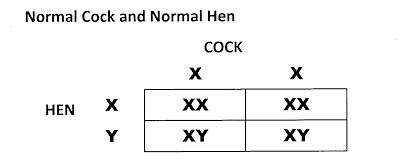 The male's two X chromosomes are along the top row and the hen's X and Y chromosomes are down the left side. Each of the 4 boxes, which represent each of the four possible combinations, then gets the cock's chromosome above the box and the hen's chromosome to the lef tof the box. So we end up with two boxes with XX - the sons, and two boxes with XY - the daughters. The next case is a Cinnamon cock and a normal hen, which means both of the cock's X chromosomes are carrying the cinnamon gene - represented by X c 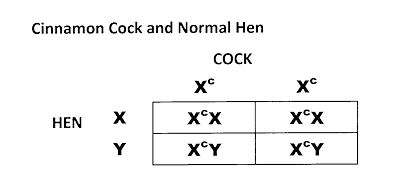 By the same process as before for each box we end up with two X cX babies - males split to cinnamon since the X masks the X c, and two X cY females - the Y means they have to be female and the Y chromosome cannot mask the colours in the X chromosome so they are cinnamon in colour. The other possibilities are given in the matrix's below, remembering the following chromosome combinations result in:- XX Normal Cock X cX Normal Cock split to Cinnamon X cX c Cinnamon Cock XY Normal Hen X cY Cinnamon Hen 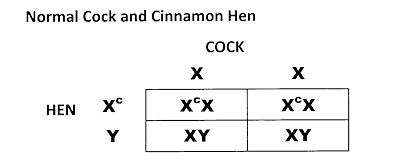 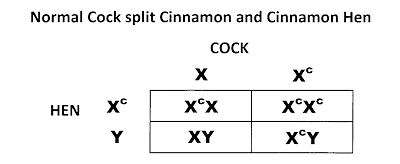 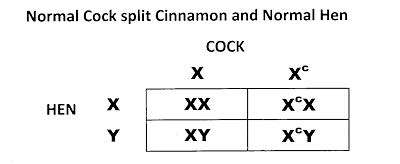 Hopefully that has sorted out basic sex-linked genetics for everyone - if you are still confused, don't worry, it took me a while to get it sorted out in my mind as well. Things can get more complex very quickly of course - for instance in cockatiels you could have a cinnamon pearl cock bird and a lutino pearl hen - both parents carrying 2 sex-linked genes and three sex-linked genes in total. The matrix system can be used to work that out but these days only masochists would bother and instead just go to Gencalc - www.gencalc.com/ - instead and let the computer work it out. cheers, Mike |
|
|
|
Post by theshadiestoneau on Sept 23, 2011 17:28:51 GMT 10
i just found this add on petlink so please explain lol a split female  ? -------------------------------------------------------------------------------- I have 6 babies still in the nest that are yet to be pulled out for handraising I am taking deposits now- they will go quickly The parents are: Male= Straight Greencheek Female= Yellowsided Split Cinnamon The babies will be ready by November Last years clutch was: 1 x greencheek 1 x pineapple 1 x yellowsided 1 x cinnamon Prices between $200-$400 depending on feathers Perfect pets for young children/ families DNA certificates available for parents Nest sexing will be conducted |
|
|
|
Post by Robyn on Sept 23, 2011 18:36:39 GMT 10
They would have to have a double split cock bird & a yellowsided hen to produce the offspring the say they got. Hens can't be split in this case they have to be visual.
Maybe they made a BOO BOO.
|
|
|
|
Post by avinet on Sept 23, 2011 23:13:33 GMT 10
They would have to have a double split cock bird & a yellowsided hen to produce the offspring the say they got. Hens can't be split in this case they have to be visual. Maybe they made a BOO BOO. More likely they just don't know what they are talking about - since both Cinnamon and yellow-sided (properly called opaline) are sex-linked, the male has to be split to both those colours, and no point in getting the cinnamon sexed - it has to be a female. Likewise as Robyn said, the female cannot be split to cinnamon sinc eit is a sex-linked gene - see my early post about sex-link genetics earlier in this thread. cheers, Mike |
|
|
|
Post by theshadiestoneau on Sept 24, 2011 9:44:23 GMT 10
found this Attachments:
|
|
|
|
Post by avinet on Sept 24, 2011 10:55:17 GMT 10
Nice chart, and it shows that as Robyn and I said, that the cock must be split to cinnamon and yellow-sided to get the results the breeder got with the first nest. cheers, Mike |
|